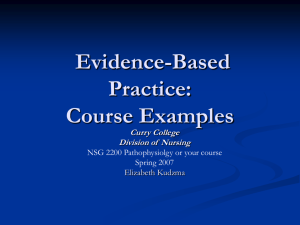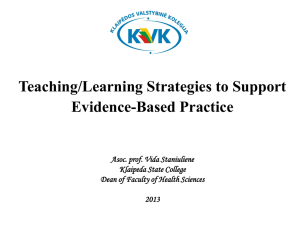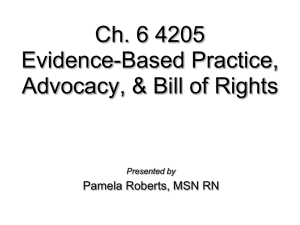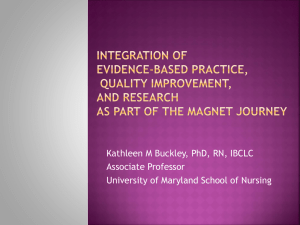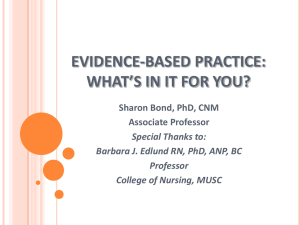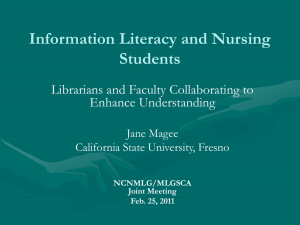Evidence-Based Practice - Hong Kong Sanatorium & Hospital
advertisement
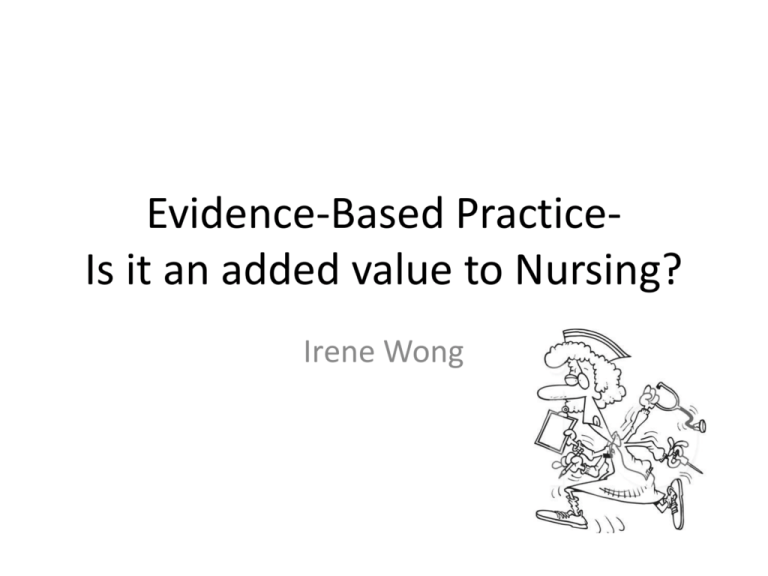
Evidence-Based PracticeIs it an added value to Nursing? Irene Wong What is it (and what it isn’t)? "Evidence-based medicine is the integration of best research evidence with clinical expertise and patient values." (Sackett D et al. Evidence-Based Medicine: How to Practice and Teach EBM, 2nd edition. Churchill Livingstone, Edinburgh, 2000, p.1) Evidence-based practice is an approach to health care wherein health professions use the best evidence possible, i.e. the most appropriate information available, to make clinical decisions for individual patients. (McKibbon, 1998) • An integration of: (a) clinical expertise/expert opinion, (b) external scientific evidence, and (c) client/patient/caregiver values to provide high-quality services reflecting the interests, values, needs, and choices of the individuals we serve. http://www.asha.org/members/ebp/intro/ What is the goal of EBP? • Goal of EBP is providing optimal clinical service to that client/patient on an individual basis. • Because EBP is a continuing process, it is a dynamic integration of ever-evolving clinical expertise and external evidence in day-to-day practice EBP in Nursing: Is it important? Why? 1. Evidence-based practice has gained momentum in nursing (1=Yes, 2=No) 5. Evidence-based practice demands changes in education of students, more practice-relevant research, and closer working relationships between clinicians and researchers. (1=Yes, 2=No) 2. Research findings, knowledge from basic science, clinical knowledge, and expert opinion are all considered "evidence“ (1=Yes, 2=No) 6. Evidence-based practice also provides opportunities for nursing care to be more individualized, more effective, streamlined, and dynamic, and to maximize effects of clinical judgment. (1=Yes, 2=No) 3. Practices based on research findings are more likely to result in the desired patient outcomes across various settings and geographic locations. (1=Yes, 2=No) 7. When evidence is used to define best practices rather than to support existing practices, nursing care keeps pace with the latest technological advances and takes advantage of new knowledge developments. (1=Yes, 2=No) 4. The impetus for evidence-based practice comes from payor and healthcare facility pressures for cost containment, greater availability of information, and greater consumer savvy about treatment and care options. (1=Yes, 2=No) Youngblut JM1, Brooten D. AACN Clin Issues. 2001 Nov;12(4):468-76. School of Nursing, Florida International University, USA What is professional responsibility in Nursing? 1. Respect the dignity, uniqueness, values, culture and beliefs of patients/clients and their families in the provision of nursing care. 2. Hold in confidence personal information obtained in a professional capacity. 3. Safeguard informed decision-making and the wellbeing of patients/clients in the provision of care. 4. Provide safe and competent nursing care. 5. Maintain the agreed standard of practice. 5.1 The nurse is responsible for ensuring that the standard of nursing practice is congruent with the agreed standards of the profession. 5.2 The nurse participates in identifying, implementing and evaluating evidence-based practices. 5.3 The nurse recognizes the need for lifelong learning and participates in continuing nursing education. 5.4 The nurse is active in updating her knowledge and skills at regular intervals to enhance professional competence. 5.5 The nurse observes occupational health and safety at work, and observes the health and safety rules for fostering self and other colleagues’ wellbeing and safety in practice situations. 6. Foster the trust that is inherent in the privileged relationship between nurses and their patients/clients. 7. Uphold the image of nurses and the profession by refusing advantages. 8. Practise in accordance with laws of Hong Kong relevant to the area of nursing practice. Code of Professional Conduct and Code of Ethics for Nurses in Hong Kong • SCOPE OF CORE-COMPETENCIES OF REGISTERED NURSE – Competence area 4: Research • 13b. Ability to collect, analyse, interpret and use research data to improve nursing and health care practices – implementing evidence-based practice • SCOPE OF CORE-COMPETENCIES OF ENROLLED NURSE – Competence area 3: Personal and Professional Attributes • maintain updated knowledge and skills to enhance effective and efficient practice. Code of Professional Conduct and Code of Ethics for Nurses in Hong Kong What nurses need to know, do to offer evidence-based care? • Implementation of EBP places additional demands on nurses to apply credible evidence to individual patient situations through searching related evidence, using clinical judgments, and considering patient values and resources. • Nurses must have the ability to– – – – – Identify knowledge gaps, Formulate relevant questions, Conduct an efficient literature search, Apply rules of evidence to determine the validity of studies, Apply the literature findings appropriately to the patient’s problem, and – Appropriately involve patient in the clinical decision making Majid et al. (2011). Adopting evidence-based practice in clinical decision making: nurses’ perceptions, knowledge, and barriers. J Med Libr Assoc 99(3). What would help us implement EBP? Bernadette Melnyk, dean of the Ohio State University College of Nursing and chief wellness officer for Ohio State said that: • EBP is not something that’s just “nice to do” anymore. This is something that we have got to do to improve quality and safety in heath care and to improve patient outcomes. • We have enough studies to show that evidence-based care can produce good results, fewer complications and hospital readmissions and shorter LOS. But we are talking about behavior change for clinicians, and that’s not a simple process. How to implement EBP? • The following are 4 key steps in the EBP process: – Step 1: Framing the Clinical Question – Step 2: Finding the Evidence – Step 3: Assessing the Evidence – Step 4: Making the Decision Step 1: Framing the Clinical Question • The first step in applying evidence to a clinical decision is framing the specific question about which evidence will be sought. • One widely-used approach to framing these questions is known as PICOS, for Population, Intervention, Comparison, Outcome. • Ensuring that the clinical question addresses all four of these areas will help to ensure that the evidence will be relevant to the particular circumstance faced by the clinician. • e.g. "Are patients with aphasia who received speech therapy services shortly after their stroke more or less likely to achieve functional communication abilities than stroke patients who received such treatments later?". Step 2: Finding the Evidence • Ideally, evidence-based clinical practice guidelines relevant to your clinical question will already exist . When that is not the case, however, the clinician needs to seek out scientific evidence to help inform the treatment decision. • Two major types of evidence may be useful: – Systematic Reviews • Cochrane Collaboration, JBI COnNECT+ Reviews, ASHA/N-CEP's Compendium of Guidelines and Systematic Reviews, Evidencebased Communication Assessment and Intervention (EBCAI) Journal – Individual Studies • Data base: OVID, EBSCO, CINAHL, MEDLINE • Jounals: JCN, JAN, JWC, JCN, JGN, JNE, JNA, NR, EBN Step 3: Assessing the Evidence • Example of a hierarchy of levels of evidence. Level Description Ia Well-designed meta-analysis Ib Well-designed randomized controlled study IIa Well-designed controlled study without randomization IIb Well-designed quasi-experimental study III Well-designed non-experimental studies, i.e., correlational and case studies IV Expert committee report, consensus conference, clinical experience of respected authorities • Conduct a research Adapted from the Scottish Intercollegiate Guidelines Network Step 4: Making the Decision • Finally, the time will come to combine clinical expertise, the patient's perspective, and the available scientific evidence in making a specific clinical decision with a specific patient. • There are at least three important factors to keep in mind when considering whether and to what extent to follow the guidance contained in such documents. – relevance of the guideline to your specific clinical question – the extent to which clinical practice guidelines are truly evidenced-based – who wrote and published the guideline What is the impact of EBP in Nursing? • The entry of EBP onto the healthcare improvement scene constitutes a major paradigm shifts in the research-to-practice effort. A new field of science to build the “evidence of evidence- based practice” (Shojania & Grimshaw, 2005). • While nurses had positive attitudes toward EBP and wished to gain more knowledge and skills, they still faced significant barriers in employing it in practice. (Melnyk et al, 2012). What are the advantages, changes, and issues in EBP? ? What can we do? End
